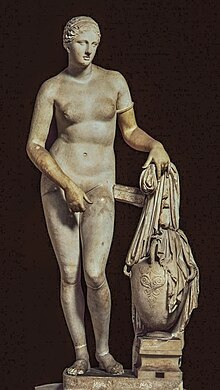
The Colonna Venus is a Roman marble copy of the lost Aphrodite of Cnidus sculpture by Praxiteles, conserved in the Museo Pio-Clementino as a part of the Vatican Museums' collections. It is now the best-known and perhaps most faithful Roman copy of Praxiteles's original.
The Colonna Venus is one of four marble Venuses presented in 1783 to Pope Pius VI by Filippo Giuseppe Colonna; this, the best of them, was published in Ennio Quirino Visconti's catalogue of the Museo Pio-Clementino, where it was identified for the first time as a copy of the Cnidian Venus. Immediately it eclipsed the somewhat flaccid variant of the same model that, as the Belvedere Venus, had long been in the Vatican collections. During the 19th and early 20th centuries, a prudish tin drape was modestly wrapped around the legs of the Colonna statue – this was removed in 1932, when the statue was removed to the Gabinetto delle Maschere where it can be seen today.
When Christian Blinkenberg wrote the first modern monograph of the Cnidian Aphrodite in 1933, he found the Colonna Aphrodite and the Belvedere Aphrodite to most accurately reflect the original, mediated through a Hellenistic copy.
Notes
- The Vatican Venus was first referred to in a document of 1536, as a recent gift to the Pope (Paul III Farnese from the Governor of Rome. Though provided with stucco drapery, it was removed from public view by Pope Gregory XIV, "nemico di ogni nuditá dell'arte" and placed in storage, all access to it forbidden; it remains in storage at the Vatican Museums today.
- "by a misplaced sense of pretended decency" Adolf Michaelis wrote, in "The Cnidian Aphrodite of Praxiteles", The Journal of Hellenic Studies, 8 (1887), p 324.
References
- L1.Don Filippo III Giuseppe Colonna, principe di Paliano and hereditary Gran Connestabile of Naples; see Haskell and Penny 1981:331, as "the Conestabile Colonna".
- Visconti, Ennio Quirino. "Plate XI.". Il Museo Pio-Clementino. Vol. 1.
- Haskell & Penny (1981), cat. no. 90, pp 330-31.
- Haskell & Penny (1981), p. 331.
- Blinkenberg, Christian (1933). Knidia; Beiträge zur Kenntnis der praxitelischen Aphrodite (in German). Copenhagen: Levin & Munksgaard.; his view is supported by Pfrommer, M. (1985). "Zur Colonna Venus: ein späthellenistische Redaktion der Knidischen Aphrodite". Istanbuler Mitteilungen. 35: 173–80.
- Mitchell Havelock, Christine (2010) . The Aphrodite of Knidos and her successors : a historical review of the female nude in Greek art. Ann Arbor: University of Michigan Press. p. 26. ISBN 9780472032778.
Sources
- Haskell, Francis; Penny, Nicholas (1981). The most beautiful statues: the taste for antique sculpture: 1500-1900. Oxford: Ashmolean Museum. ISBN 9780900090837.
Gallery
-
 The Colonna Venus
The Colonna Venus
-
 Colonna Venus: right side view
Colonna Venus: right side view
-
 The Colonna Venus with its tin draperies, as it was displayed until 1932.
The Colonna Venus with its tin draperies, as it was displayed until 1932.
This article about a sculpture in the Vatican City is a stub. You can help Misplaced Pages by expanding it. |